Rocks and minerals are fundamental components of Earth’s crust, offering insights into its history and structure․ Rocks are aggregates of minerals, while minerals are naturally occurring inorganic solids with distinct chemical and physical properties․ Understanding their formation, composition, and classification helps uncover Earth’s geological processes and resources․
What are Rocks?
Rocks are solid masses of mineral material that make up the Earth’s crust․ They can be composed of one or more minerals and are classified into three main types: igneous, sedimentary, and metamorphic․ Igneous rocks form from cooled magma or lava, while sedimentary rocks develop from compressed sediments like sand or clay․ Metamorphic rocks are transformed from pre-existing rocks under high pressure and temperature․ Rocks vary widely in texture, color, and composition, with granite, basalt, and sandstone being common examples․ Their study, known as petrology, reveals insights into Earth’s geological history and processes․ Rocks are essential for understanding the planet’s structure and natural resources․
What are Minerals?
A mineral is a naturally occurring, inorganic solid with a specific chemical composition and a crystalline structure․ Minerals are formed through geological processes and have distinct physical and chemical properties, such as hardness, color, and crystal shape․ There are over 3,000 known minerals on Earth, with quartz, feldspar, and mica being among the most common․ Minerals are the building blocks of rocks and can occur alone or in combination․ Their properties, like hardness and luster, are used for identification․ Minerals are also vital for various industrial applications, making them essential for understanding Earth’s composition and natural resources․

Types of Rocks
Rocks are classified into three main types: igneous, sedimentary, and metamorphic, each formed through distinct geological processes․ Igneous rocks originate from magma or lava, sedimentary rocks from compressed sediments, and metamorphic rocks from transformed existing rocks under high pressure and temperature conditions․ This classification helps in understanding their composition and formation, which are essential for studying Earth’s geology and resource distribution․
Igneous Rocks
Igneous rocks are formed from the cooling and solidification of magma or lava, a process that can occur either beneath the Earth’s surface (intrusive) or above it (extrusive)․ Intrusive rocks, like granite, cool slowly, resulting in large, visible mineral crystals․ Extrusive rocks, such as basalt, cool rapidly, creating fine-grained textures․ The composition of igneous rocks varies widely, ranging from felsic, which is rich in silica, to mafic, which is rich in magnesium and iron․ Common examples include obsidian, a glassy rock formed by rapid cooling of lava, and pumice, characterized by its porous structure․ Igneous rocks provide valuable insights into Earth’s thermal and volcanic activities․
Sedimentary Rocks
Sedimentary rocks are formed through the accumulation and compression of sediments, such as mineral particles, organic matter, or chemical precipitates․ These rocks can originate from erosion of pre-existing rocks, decomposition of organic material, or chemical precipitation from solutions․ Over time, layers of sediment are compacted and cemented together, creating a new rock․ Common types include clastic sedimentary rocks like sandstone and shale, chemical sedimentary rocks like limestone, and organic sedimentary rocks like coal․ Sedimentary rocks often exhibit distinctive features such as bedding planes and fossils, which provide valuable information about Earth’s history and past environments․ They also serve as important reservoirs for natural resources, including oil, gas, and groundwater․
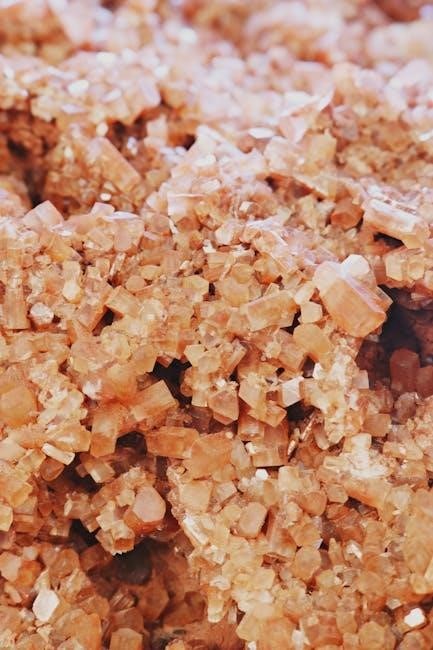
Metamorphic Rocks
Metamorphic rocks are formed when existing rocks—igneous, sedimentary, or other metamorphic rocks—are subjected to high temperatures and pressures, causing mineralogical and structural changes․ This transformation occurs without melting the rock, often deep within Earth’s crust․ Common examples include marble, formed from limestone, and slate, derived from shale․ Metamorphic rocks exhibit unique textures like foliation, which result from the alignment of minerals under stress․ These rocks provide critical insights into Earth’s tectonic activity and the conditions of the crust over millions of years․ They are also valuable sources of minerals and ores, making them significant in both geological study and economic applications․
The World of Minerals
The world of minerals encompasses a diverse array of naturally occurring inorganic solids, each with unique physical and chemical properties, forming the foundation of Earth’s geology and resources․
Mineral Properties
Mineral properties are the unique characteristics used to identify and classify minerals․ These include hardness, measured on the Mohs scale, color, luster (appearance in light), streak (powder color), cleavage (fracture pattern), density (mass per volume), and crystal form․ Hardness reflects resistance to scratching, while luster indicates light reflection․ Streak helps identify minerals like hematite, which may appear red when powdered․ Cleavage patterns, such as cubic in halite, reveal atomic structure․ Density distinguishes minerals like pyrite (iron sulfide) from similar-looking gold․ Crystal form varies, with quartz forming hexagonal crystals․ These properties, combined, provide a systematic way to identify minerals accurately․
Common Rock-Forming Minerals
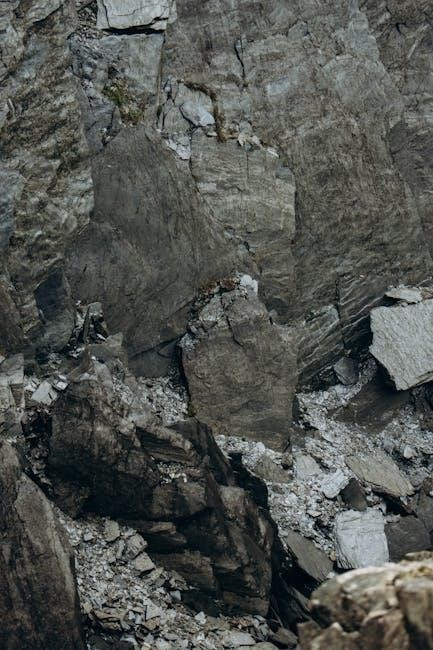
Common rock-forming minerals include quartz, feldspar, mica, amphibole, and calcite․ These minerals are prevalent in igneous, sedimentary, and metamorphic rocks․ Quartz, one of the most abundant, forms hexagonal crystals and is highly resistant to weathering․ Feldspar is another key mineral, often found in igneous rocks like granite․ Mica is recognizable for its shiny, flaky appearance and is common in metamorphic rocks․ Amphibole and calcite are also widespread, with calcite often forming sedimentary rocks like limestone․ These minerals provide essential insights into the composition and origin of rocks, making them foundational in geological studies․
Formation of Rocks and Minerals
Rocks and minerals form through geological processes like magma cooling, sediment compression, or metamorphic transformations․ Igneous, sedimentary, and metamorphic rocks emerge from these dynamic Earth systems, shaping our planet․
How Igneous Rocks Form
Igneous rocks form through the cooling and solidification of magma or lava․ This process can occur beneath Earth’s surface (intrusive) or above it (extrusive)․ Intrusive rocks like granite cool slowly, forming large crystals, while extrusive rocks like basalt cool rapidly, creating fine textures․ The composition of magma, rich in silica or mafic, influences the rock type․ Volcanic activity and tectonic movements drive this process, shaping the Earth’s crust with diverse igneous formations․
How Sedimentary Rocks Form
Sedimentary rocks form through the accumulation and compression of sediments, such as sand, silt, clay, or organic material․ These sediments, often eroded from pre-existing rocks, are transported by water, wind, or ice and deposited in a new location, like oceans or river deltas․ Over time, layers of sediment are compacted by overlying weight, and minerals from water cement the grains together․ Additionally, sedimentary rocks can form through chemical precipitation or the accumulation of organic remains, such as plant or animal matter․ This process creates distinct textures and compositions, resulting in rocks like sandstone, shale, limestone, and conglomerate․
How Metamorphic Rocks Form
Metamorphic rocks are formed through the transformation of pre-existing rocks under high pressure and temperature conditions, without melting․ This process occurs deep within the Earth’s crust, often due to tectonic forces or mountain-building events․ The original mineral composition and structure of the rock are altered, creating new minerals and textures․ For example, shale can transform into slate, and limestone into marble․ Heat and pressure cause minerals to recrystallize, resulting in distinctive patterns like foliation․ This transformation does not involve melting but reshapes the rock’s internal structure, leading to unique properties․ Metamorphic rocks provide valuable insights into Earth’s tectonic history and the conditions that shape our planet․
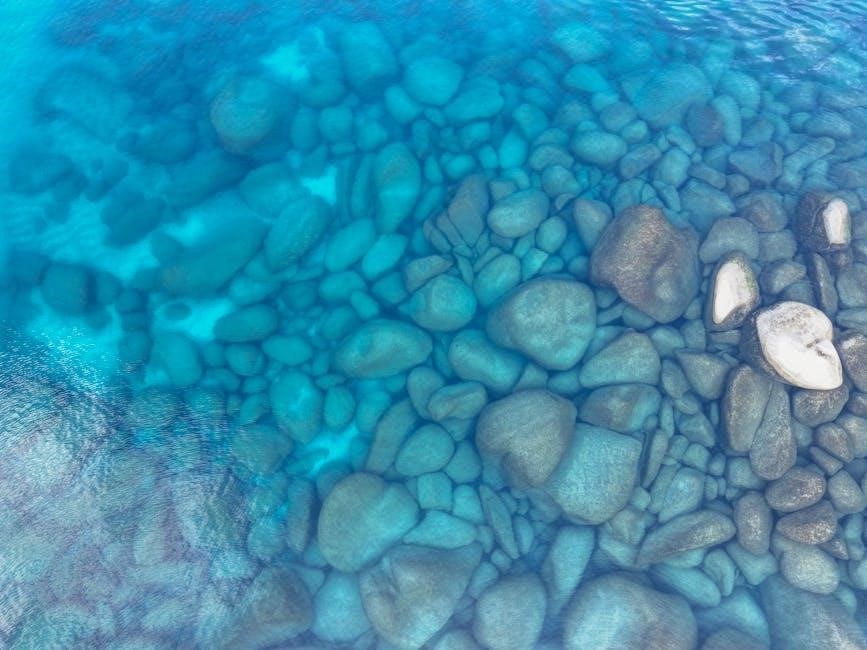
Identifying Minerals
Minerals are identified using key properties like hardness, color, luster, streak, cleavage, and crystal shape․ These characteristics help distinguish one mineral from another accurately and efficiently․
Key Properties for Mineral Identification
The identification of minerals relies on specific physical properties, including hardness, color, luster, streak, cleavage, and crystal shape․ Hardness measures resistance to scratching, often assessed using the Mohs scale․ Color and streak, the powder color, help distinguish minerals, though they can vary․ Luster refers to how light reflects off the surface, such as metallic or glassy․ Cleavage describes how minerals break along flat surfaces, while fracture explains irregular breaks․ Crystal shape reveals the mineral’s internal structure․ These properties, combined, provide a systematic approach to identifying minerals accurately and understanding their unique characteristics․
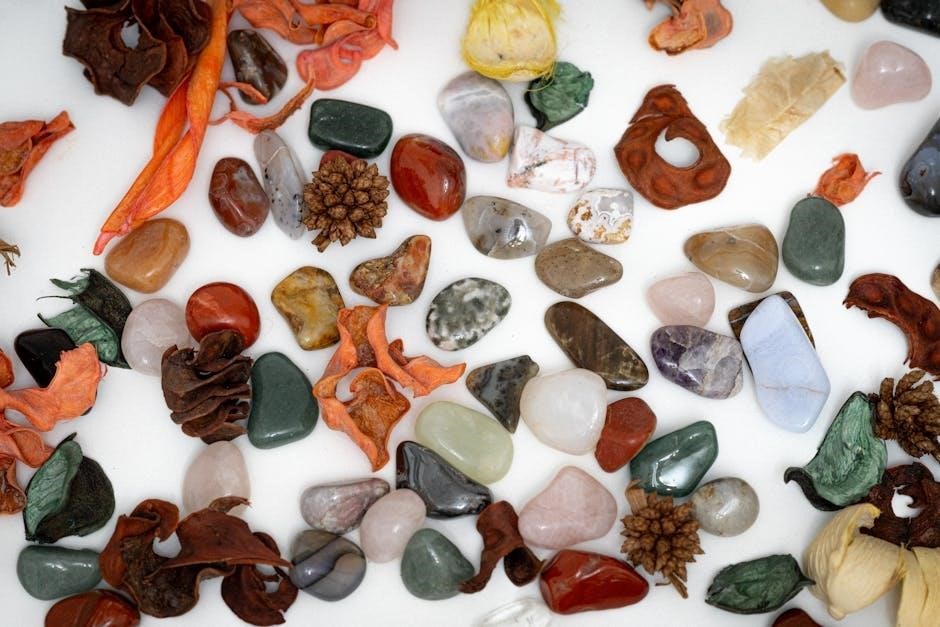
Economic Importance of Rocks and Minerals
Rocks and minerals are vital resources, driving industries like construction, electronics, and energy․ They provide essential materials for infrastructure, technology, and daily life, fueling economic growth and innovation․

Mineral Resources and Their Uses
Mineral resources are crucial for various industries, providing raw materials for construction, technology, and energy․ Quartz, feldspar, and mica are common in electronics and construction․ Metals like iron, copper, and aluminum are essential for manufacturing and infrastructure․ Energy resources, such as coal, oil, and natural gas, power industries and households․ Rare earth minerals, like neodymium and lithium, are vital for renewable energy technologies and electronics․ Minerals also contribute to agriculture, medicine, and jewelry․ Their extraction and processing drive economic growth, create jobs, and enable innovation․ However, sustainable practices are essential to balance resource use with environmental preservation for future generations․
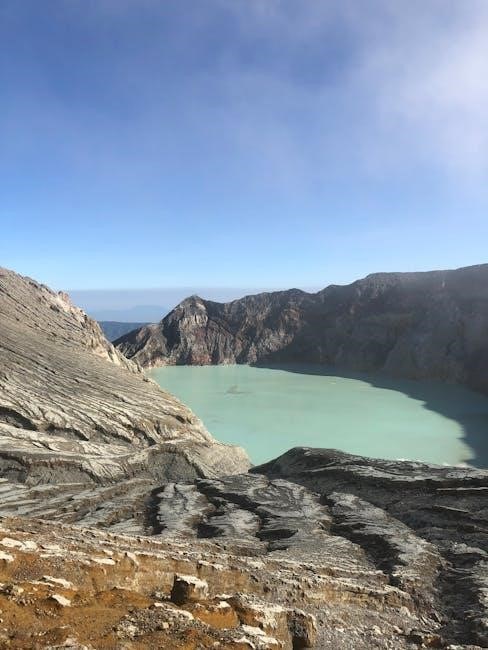
Environmental Impact of Rocks and Minerals
Mining for mineral resources impacts ecosystems through deforestation, water pollution, and soil degradation․ Sustainable practices are essential to mitigate environmental harm and promote eco-friendly mineral extraction․
Role of Rocks and Minerals in Earth’s Processes
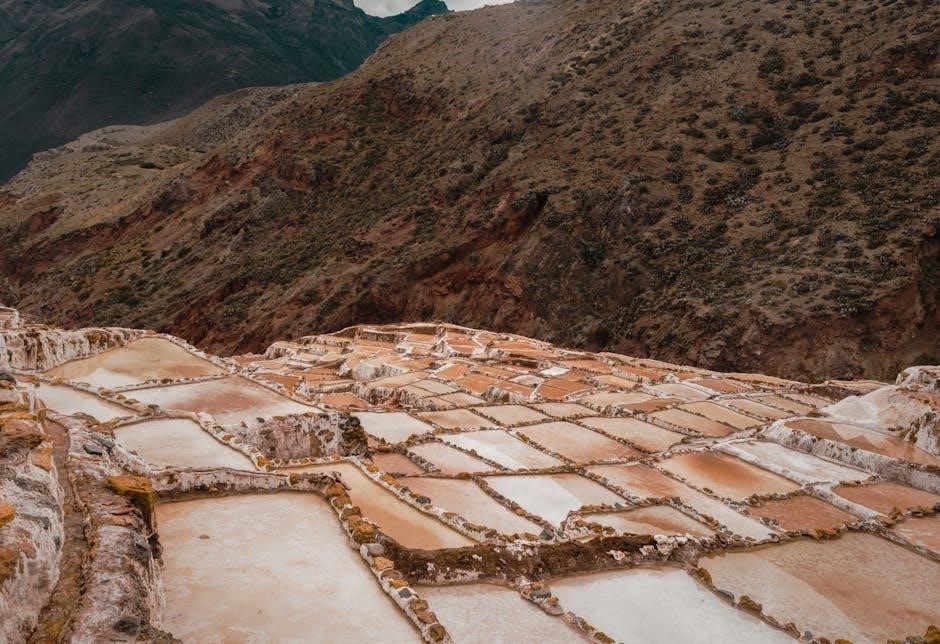
Rocks and minerals play a vital role in Earth’s geological processes, shaping landscapes and influencing climate․ They form the foundation of plate tectonics, driving processes like earthquakes and volcanism․ Weathering and erosion of rocks recycle minerals, replenishing soil and oceans․ Minerals such as silicates and carbonates regulate Earth’s systems, storing carbon and moderating atmospheric conditions․ Rocks and minerals also act as natural archives, preserving Earth’s history through fossils and geochemical records․ Their dynamic cycles ensure the continuous transformation of the planet, sustaining life and resources essential for ecosystems and human activities․